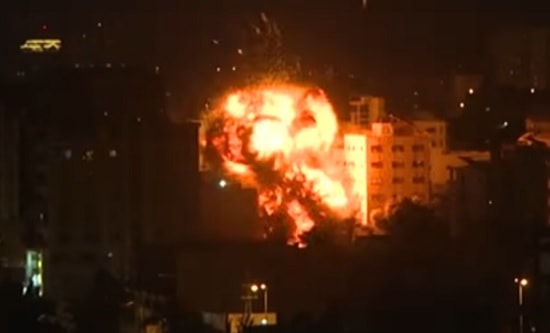
On 2 May 2019, the Israeli state began a new round of airstrikes on the Gaza Strip. The four days of fighting that ensued saw Israel launch over 350 airstrikes on Gaza, one of the most densely populated and impoverished regions in the world. 25 Palestinians were killed, including three children, according to the Health Ministry in Gaza. Hamas and Islamic Jihad, the leading armed groups in Gaza, retaliated with rocket attacks into Israel that killed four. The corporate media’s reporting of these events demonstrates its pro-Israel bias. WESAM KHALED reports.
The fighting began when Israel launched airstrikes on Gaza in the early hours of 2 May, allegedly in response to incendiary kites and balloons launched from Gaza into Israel. Palestinians have been sending incendiary kites into Israel as a form of protest against the crushing Israeli blockade of Gaza; thus far they have only caused property damage. Islamic Jihad immediately responded to the Israeli strikes with rocket fire on the same day. The next day, Israel launched further airstrikes, killing two Palestinians. It also gunned down two Palestinians at the weekly March of Return protest at the Gaza-Israel border, where two Israeli soldiers were injured by a Palestinian fighter. The fighting continued over the weekend until a ceasefire was announced on 6 May.
Despite this sequence of events, the corporate media in Britain was quick to cast Palestinian attacks as the cause of the fighting. A BBC headline on 5 May read: ‘Gaza rocket barrage prompts Israel strikes’ – casting the Palestinians as the instigators. The article goes on to tell us that the first act of violence in this conflagration was the injuring of the two Israeli soldiers on 3 May. No mention at all is made of Israel’s early-morning airstrike on 2 May.
The supposedly left-leaning Guardian gave us a similarly-distorted narrative. ‘Six killed in Gaza as Israel responds to multiple rocket attacks’ was the title of one article (5 May 2019) which repeated the lie that the fighting erupted due to the violence at the demonstrations on 3 May. Other corporate media outlets reported on the events in similar terms. Virtually no mention of Israel’s initial airstrikes is made in any of the mainstream media.
This media one-sidedness is a well-worn tactic. The Palestinians are constantly cast as the aggressors while Israel is cast as their victim whose violence is always in retaliation or self-defence. Whether it is Palestinian rockets being fired or a Palestinian gunman injuring Israeli soldiers, for the corporate media the timeline always begins with an act of Palestinian violence to which Israel is merely forced to respond. This is a complete inversion of the reality. Israel launched the first attack in this latest round of fighting; but more than that, the situation Israel imposes on Palestinians in Gaza is one of daily violence and oppression. Over two-thirds of Palestinians in Gaza are refugees or the descendants of refugees who were ethnically cleansed from the land that is now the Israeli state and refused their right to return. Israel maintains a crippling siege on Gaza that has seen the poverty rate rise to 80% and the unemployment rate to 54%. The UN stated in May that unless further aid is secured, one million people in Gaza would be left without food by June. Every one of these factors is an act of violence to which Palestinian resistance is more justified than any Israeli ‘retaliation’; yet in the corporate media, these factors are downplayed, if they are mentioned at all, and we are left with an image of senseless Palestinian violence without a reasonable cause.
Ceasefire conditions broken by Israel
This was the first major outbreak of hostilities since a similar round of fighting in March. Those hostilities ended in a ceasefire, one of the conditions of which was that Israel would allow much-needed aid from Qatar into the Gaza Strip. Qatar has pledged hundreds of millions of dollars in relief aid to Gaza over recent years, including a pledge to send $30m dollars a month in early 2019. Hamas said that Israel had been delaying these aid payments, further exacerbating the humanitarian crisis in Gaza. Another condition of the ceasefire was that Israel would allow Gazan fishermen to fish beyond the six-nautical-mile limit arbitrarily imposed by Israel in Gazan waters. The Zionists broke both of these conditions, continuing to block the Qatari aid and routinely firing on Palestinian fishing boats. Hamas cited both of these as factors which fuelled the most recent violence.
The ceasefire which ended the recent hostilities once again requires Israel to allow the Qatari aid into Gaza. Whether Israel will abide by its terms this time remains to be seen. Already by 16 May, Israel had once again reduced the permitted fishing zone in Gaza’s waters from 12 nautical miles to five.




